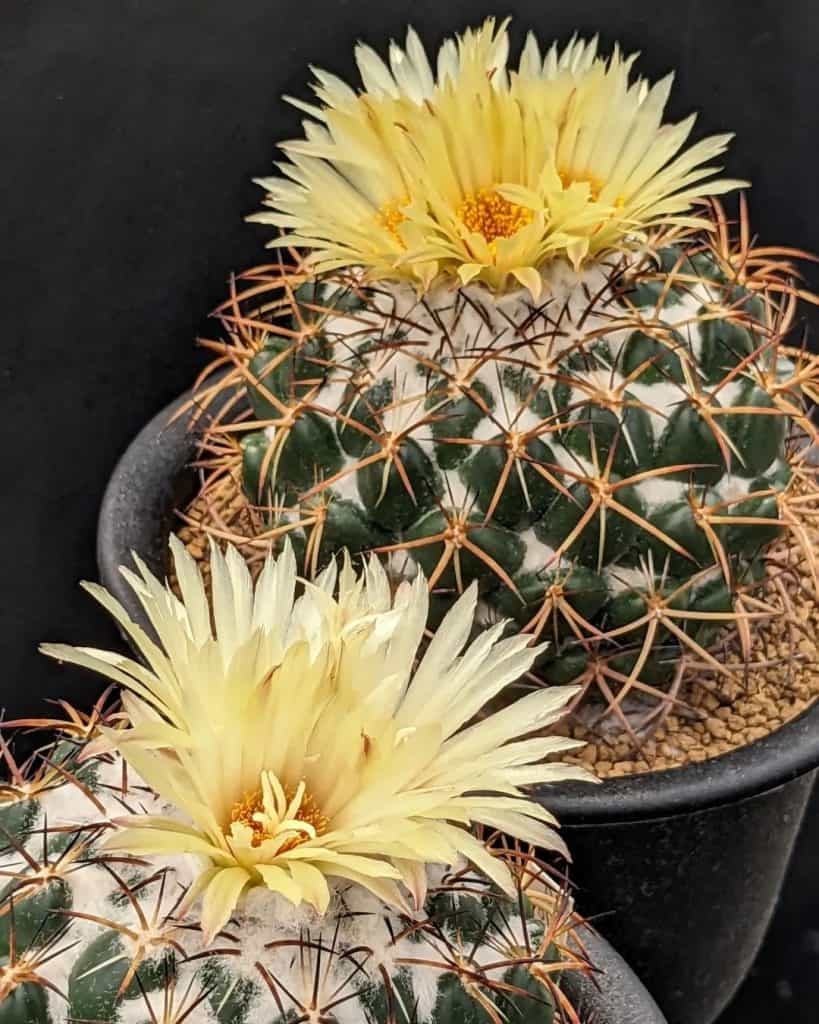Coryphantha Greenwoodii: Redefining Cactus Beauty, One Spine at a Time
You know those prickly cacti that make you go “ouch” just by looking at them? Well, get ready to have your mind blown by a cactus that’s equal parts stunning and spiky – the Coryphantha greenwoodii. This desert dweller is about to rewrite everything you thought you knew about cactus beauty!

Contents
About Coryphantha Greenwoodii
Instead of the typical ribbed body, this globular green gem is decked out in large, flattened tubercles that are wider than they are tall. And wait till you see the armory on each one – clusters of 5-8 curved, reddish-brown spines that radiate outwards like a stylish hairdo. Talk about cactus couture!
But here’s the real showstopper – the blooms on this prickly prima donna. Imagine creamy white petals with a pop of pink or purple in the center. Some greenwoodii even flaunt sunny yellow flowers, like a burst of desert sunshine. And they aren’t stingy with the goods either – these big beauties can reach up to 4-7 inches wide!
Related Post:
1,000 Types of Cactus [With Pictures]
How to Care for Coryphantha greenwoodii
Light
Full sun is where the greenwoodii shines brightest (pun intended). Aim for at least 6-8 hours of direct rays daily if growing outdoors. Indoors, a sunny south-facing window works like a charm. If natural light is scarce, deck it out with a chic grow light to keep those flowers coming.

Water
When it comes to hydration, the greenwoodii likes to live on the edge – not too much, not too little. Once every 1-2 weeks should keep this thirsty cactus happy. Overwatering is a major no-no as it can lead to rot and other nasty issues. Always allow the potting mix to fully dry out before reaching for the watering can again.
Soil
Speaking of soil, let’s talk about getting the right mix. A cactus this fierce needs a growing medium that’s light, airy and well-draining. Think of combining organic matter with gritty ingredients like perlite or pumice. This ensures the roots can breathe easy while excess moisture makes a swift exit.
Fertilizer
Go easy on the plant food with this one. An annual feeding with a balanced cactus fertilizer (diluted to half-strength) is plenty. Too many nutrients can do more harm than good for our spiny superstar.
Temperature and Humidity
The greenwoodii laughs in the face of desert heat, but a frosty chill? Not so much. It prefers toasty temps between 70-90°F and low humidity levels. If you’re in a colder region (zones 9b-11), grow it in a sunny spot indoors.

Pests and Problems
You’d think all those sharp spines would be enough to keep pests at bay. But alas, mealybugs and nematodes can still cause trouble. The best defense? Proper watering – not too much, not too little. Any major infestations may need insecticides or separating healthy parts to propagate anew.
Pruning
Unlike its high-maintenance plant cousins, the greenwoodii is a no-fuss, no-prune kind of cactus. Just sit back and admire those wild spines!
Potting and Repotting
A shallow, terracotta pot with drainage holes is prime real estate for our desert dazzler. Repotting isn’t a must, but giving it some fresh soil every few years provides a nice refresh.
Propagating Coryphantha greenwoodii

What’s better than one head-turning cactus? An entire garden full of them! Luckily, the greenwoodii is easy to propagate, giving you more prickly eye-candy.
From Offsets
The greenwoodii is a suckering cactus, meaning it produces offsets or pups around the base over time. Once a pup reaches a few inches tall, you can separate it from the mother plant. Use a sharp, sterile knife to gently detach the offset, allowing the separation point to callus over for a few days before replanting.
From Seed
For the patient plant parent, you can also propagate the greenwoodii from seed. Use a well-draining seed-starting mix and keep it lightly moist until the seeds sprout. Once your new greenwoodii babies emerge, slowly acclimate them to more sunlight and drought over time. With some tender loving care, you’ll have a whole new generation of spiny showstoppers!
No matter which method you choose, propagating this quirky cactus is a great way to multiply the fun. Who wouldn’t want an entire desert garden filled with these living sculptures?
